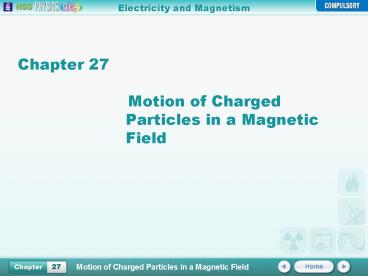Chapter 27 Motion of Charged Particles in a Magnetic Field - PowerPoint PPT Presentation
1 / 12
Title: Chapter 27 Motion of Charged Particles in a Magnetic Field
1
Chapter 27 Motion of Charged Particles in a
Magnetic Field
2
- In the presence of electric field, the electrons
experience electric forces and drift slowly in
the opposite direction of the electric field at
the drift velocity. - The drift velocity (105 m s1) of free
electrons is extremely small compared with their
mean speed (106 m s1).
3
- The current I carried by a conductor can be
expressed as
I nAvQ
- where n is the number of free charge carriers
per unit volume - A is the cross-sectional area of the conductor
- v is the drift velocity of the charge carriers
- Q is the charge carried by the charge carriers.
4
27.2 Magnetic force on a moving charge
- The magnetic force F on a moving charged particle
with a velocity v in a magnetic field B at an
angle q is given by
F BQv sin q
The direction of the force can be determined by
Flemings left hand rule.
5
- To pass through the crossed fields in a velocity
selector without deflection, the speed of the
particles must be
6
Motions of charged particles in uniform magnetic
field
- The motion of a charged particle in a uniform
magnetic field B depends on the angle q between
its initial velocity v and the direction of the
field.
q 0 or 180
F 0
rectilinear motion
7
- The motion of a charged particle in a uniform
magnetic field B depends on the angle q between
its initial velocity v and the direction of the
field.
q 90
circular motion
The centripetal force is provided by the magnetic
force acting on the particle
8
- In a mass spectrometer, the radii of the
semi-circular paths taken by the charged
particles depend on their charge to mass ratios,
so that different particles can be separated and
identified.
Recall that the radius r of the circular path is
given by
The radius r differs if the charge to mass ratios
(Q / m) differs.
9
27.3 Hall effect
Deflection of charge carriers in conductor
- When a current passes through a conductor placed
in a uniform magnetic field, each of the charge
carriers experiences a magnetic force and
deflects to the surfaces.
A conductor with positive charge carriers
A conductor with negative charge carriers
10
- The deflection of the moving charged carriers
leads to - an excess of positive (or negative) charge
carriers on the upper surface, and - a deficiency of positive (or negative) charge
carriers on the lower surface.
A conductor with positive charge carriers
A conductor with negative charge carriers
11
Hall voltage
- A p.d. is developed across the conductor due to
the deflected charge carriers. - Each charge carrier moving in the conductor
experiences an electric force that opposes the
magnetic force on it. - These two forces balance each other in the steady
state.
A conductor with positive charge carriers
A conductor with negative charge carriers
12
- The Hall effect is the production of a Hall
voltage across the opposite surfaces of a
current-carrying conductor placed in a magnetic
field, which is given by

